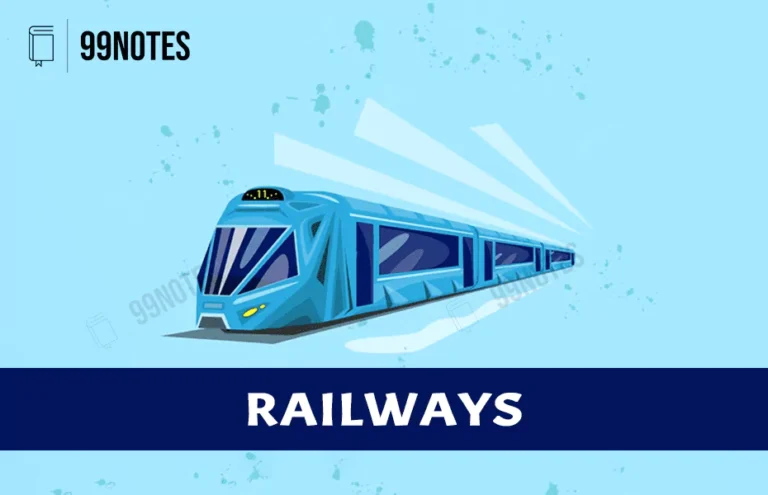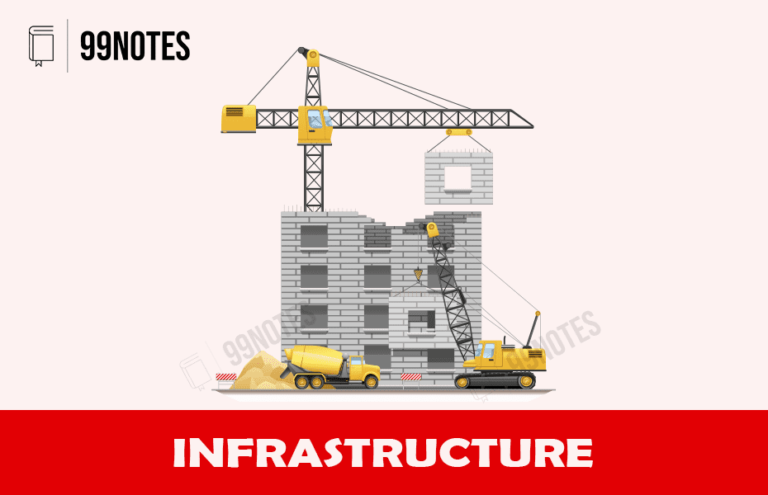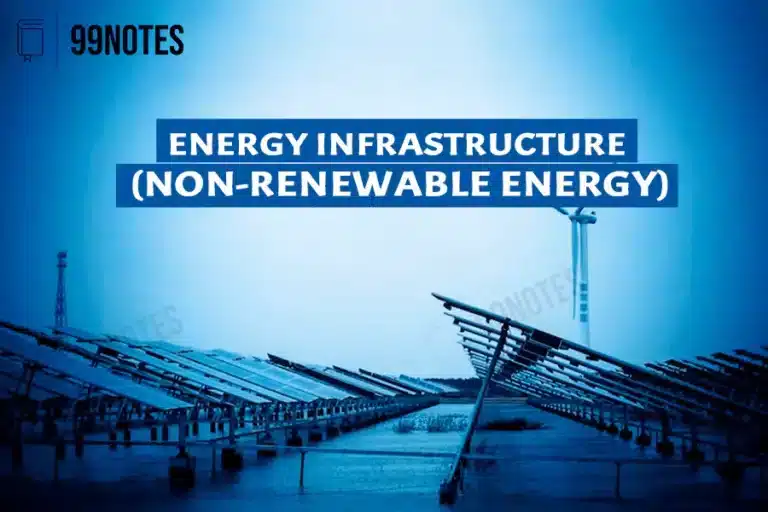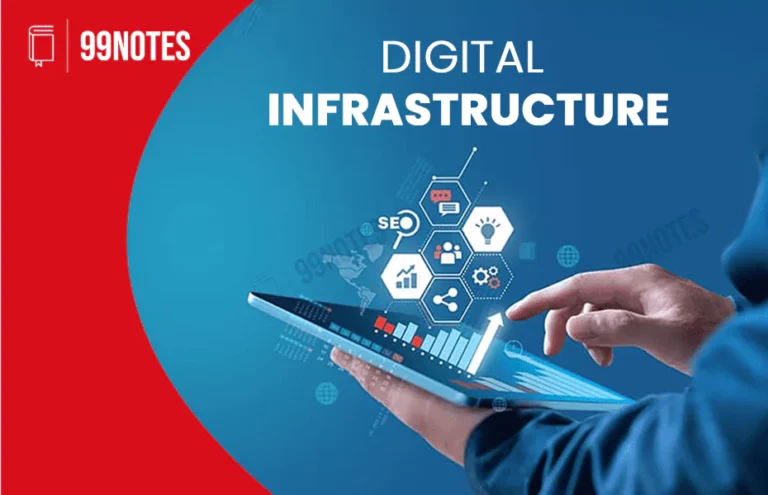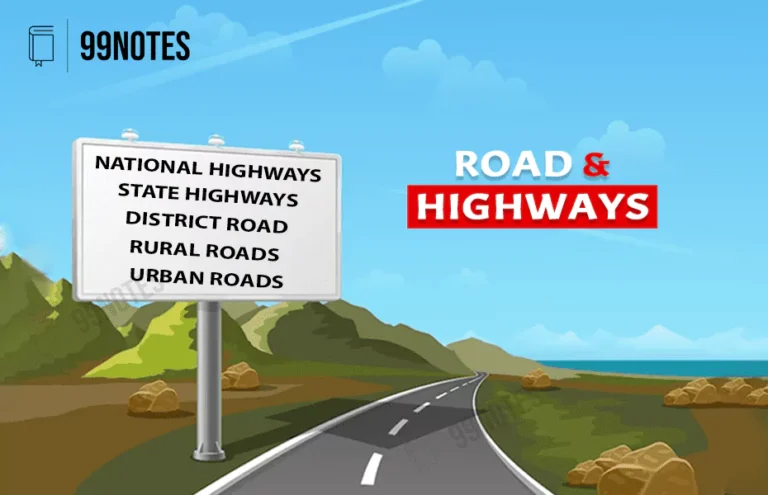Housing Sector in India
Housing Sector in India
The housing industry is one of the pillars of the economic foundations of our country and one of the fastest-growing sectors.
For our understanding in the context of policymaking and the UPSC syllabus, we shall classify the housing sector into three categories:
- Affordable Housing
- Rural Housing
- Urban Housing
AFFORDABLE HOUSING and RURAL HOUSING in INDIA
Affordable housing in India is defined as a house/flat with a 90 metre 2 carpet area in non-metropolitan cities and towns, and 60 metre2 in metropolitan cities and having a value up to Rs 45 lakh, in each case. These are also known as Economically Weaker Section (EWS) dwellings.
Housing categories in India according to the income groups:
- Economically weaker sections (EWS) are urban poor with an annual income of 3 lahks,
- Low-income group (LIG) are those with an income between 3-6 lakh,
- Middle-income group (MIG) are those with an income between 6-18 lakh.
The union government aims to provide Housing for All by 2022. In order to fulfil this aim, the government has launched the Pradhan Mantri Awas Yojana (PMAY).
Pradhan Mantri Awas Yojana (PMAY)
PMAY is a centrally sponsored scheme wherein 60% of the funds are contributed by the Centre and the rest by the states. In the case of special category states, this proportion rises to 90%.
PMAY aims to provide housing for all by 2024.
The PMAY has 2 components:
- Urban Component: Pradhan Mantri Awas Yojana (PMAY) – Urban.
- Rural Component: Pradhan Mantri Awas Yojana (PMAY) – Gramin.
Pradhan Mantri Awas Yojana (Urban) Mission, 2015:
- Implementing agency: Ministry of Housing and Urban Poverty Alleviation.
- Aim: provision of Housing for All by 2022, along with building more than 2 Crore houses in seven years for EWS and LIG.

- It envisages Government interventions for different segments of the urban poor as follows:
-
- In-Situ Slum redevelopment: Redevelopment of slums with the participation of private players using land as a resource – slum rehabilitation grant of ₹1 lakh/house on an average for all eligible slum dwellers in all such projects;
- Affordable housing for weaker sections [Credit Linked Subsidy Scheme (CLSS)]:
-
-
- Interest rate subvention at 6.5% for EWS/LIG categories so that interest payable at present is less than 4% (can fluctuate with the interest rate to the bank).
- The subsidy pay-out on a Net present value (NPV) basis would be about ₹2.3 lakh/house.
- Home loans up to ₹9 lahks will get an interest exemption of 4% [everyone].
- Home loans up to ₹12 lahks, interest exemption of 3%. [Everyone]
- This can be availed for 15 years.
-
-
- Affordable housing in PPP(AHP): Central assistance at ₹1.5lakh/EWS house in projects where 35% of the houses are mandatorily for the EWS category.
- Subsidy for beneficiary-led individual house construction (BLC): ₹1.5 lahks per house for EWS category in slums or otherwise if states/cities do a project.
-
-
- The beneficiary family should not own a personal pucca house either in her/his name or in the name of any member of her/his family in any part of the country.
- A beneficiary family will comprise a husband, wife, unmarried sons, and/ or daughters.
-
-
- Houses of up to 30 meter2carpet area are to be provided with:
-
-
- Basic civic infrastructure, i.e., water, sanitation, sewerage, road, power, telephone line, etc.
- Social infrastructure such as community centres, parks & playgrounds, livelihood centres, etc.
- Flexibility is provided in terms of determining the household size and other facilities at the state level in consultation with the respective Ministry.
- One can also avail of loans under this scheme to build toilets in existing houses.
-
-
- The “Housing for All” Action Plan was introduced by the Ministry of Housing and urban poverty Alleviation to establish housing facilities for slum dwellers.
- This scheme is being implemented in three phases:
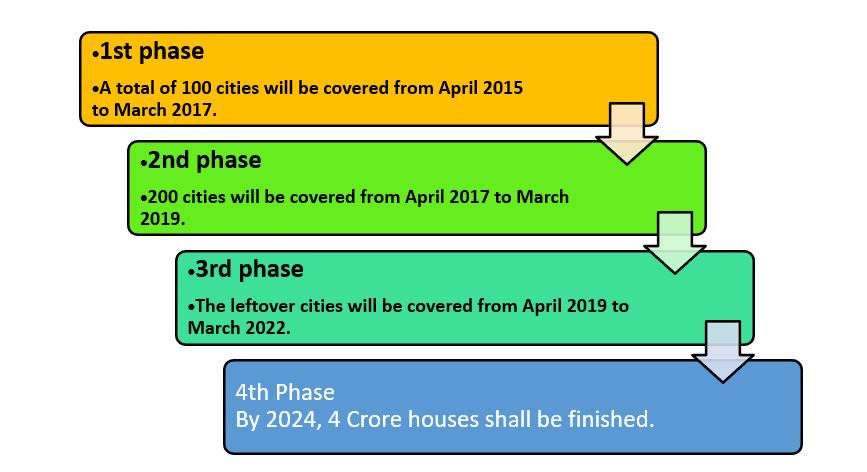
Pradhan Mantri Awaas Yojana-Gramin(PMAY-G), 2016:
- Implementing agency: Ministry of Rural Development.
- Aim: To provide houses to families below the poverty line (BPL) in rural areas.
-
- Initially, 2 crore houses were promised till 2022.
- In the 2020-21 Budget, the government allocated 10,000 crore to PMAY – Gramin and a new target of 4 crore pucca houses by 2024 for the country’s rural poor was adopted.
- Beneficiaries: Based on the Socio-Economic and Caste Census (SECC 2011) data validating it through the Gram Sabha. Covering households that are:
-
- Houseless Families or Living in houses with kutcha walls and kutcha roofs with two rooms or less (after excluding households falling under the automatic exclusion category;).
- BPL rural households of SC/ST, non-SC/non-ST, Ex-servicemen of armed & paramilitary forces killed in action, physically & mentally challenged persons, freed bonded labourers & Minorities are eligible to get assistance.
- Provisions:
-
- Enhancement of unit assistance from:
- From ₹70,000 to ₹1,20lakh in plain.
- From ₹75,000 to ₹1,3 lakh in hilly states, difficult areas and IAP districts.
- The beneficiary will get ₹12,000/- as assistance for the toilet construction under the Swachh Bharat Mission or any other dedicated source of Funding, including Swachh Bharat Kosh & MGNREGS.
- Support of 90-person days in plain areas and 95-person days in hilly states, difficult areas and IAP districts under MGNREGS through convergence.
- The eligible beneficiary can also avail of an optional loan of up to ₹70,000/-.
- Enhancement of unit assistance from:
- Features:
-
- To skill 5 lakh Masons (Rural) by 2019 and allow over 200 diverse housing designs countrywide based on a detailed study of household requirements, housing typologies, and environmental hazards.
- There is a provision for the orientation of beneficiaries.
- A 45-day on-site, hands-on skill training of Rural Masons will help poor households climb the skilling ladder.
- Large-scale use of local materials is envisaged.
- Features of House: A complete home with electricity provision, cooking space, LPG, toilet, drinking water and bathing area etc.
- In the 2021-22 budget, Union Cabinet has approved the proposal to expand PMAY-G beyond March 2021 till March 2024.
- To skill 5 lakh Masons (Rural) by 2019 and allow over 200 diverse housing designs countrywide based on a detailed study of household requirements, housing typologies, and environmental hazards.
- ICT and Space Technology:
-
- To further confirm the appropriate selection of beneficiaries and advancement of work.
- Every payment is through IT/DBT mode with Aadhaar-linked bank accounts with consent to ensure complete transparency and accountability.
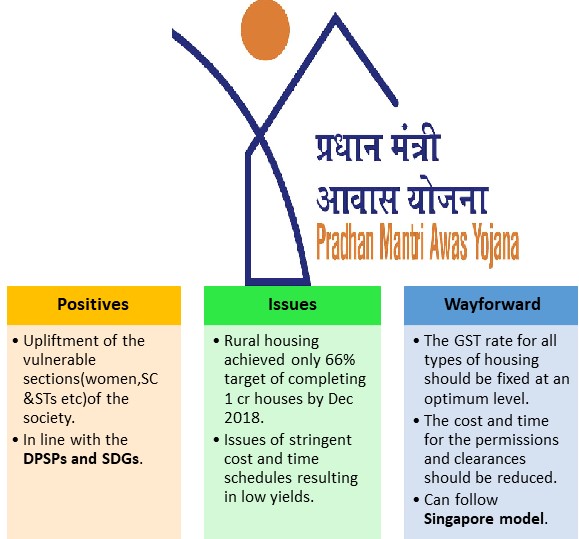
URBAN HOUSING in INDIA
The Census of India classifies all Indian urban settlements as Class I cities, Statutory towns and census towns. The 2011 Census data enumerates the following number of cities:
| Metropolitan (out of below) | Population > 10L | 53 |
| Class I cities | Population> 1L | 465 |
| Statutory towns | Places with a municipality, municipal corporation, cantonment board, or notified town area committee. | 4041 |
| Census towns | Minimum 5000 population, and a minimum of 75% employed in non-agricultural work. | 3894 |
| All class | 7953 |
Rapid Urbanisation in India:
- Present status of Urbanisation in India: As per the 2011 census,
-
- 84% population lives in villages and 31% in urban areas (around 50 Crore).
- Cities contribute to 63% of India’s GDP.
- The importance of Agriculture is declining: It currently employs over 40% of India’s workhouses, and its contribution to India’s GVA has now fallen to merely 16.4%.
- Future Projections: In the future, according to the government estimates:
-
- By 2030, the urban areas will contribute 75% of the GVA.
- Almost 60 Crore Indians, or 40% of India’s population, will live in Indian cities.
- By 2050, 80 Crore people will live in cities, i.e., 50% of the population.
This means in the next 30 years, the urban population will increase by more than 60% (from 50 Crore to 80 Crore). According to the government’s estimate, India must construct 700 to 900Mn meter2 of residential and commercial space annually until 2030 to be ready to handle the influx of migration into the cities.
Challenges faced in the housing sector in India:
- Governance Issues:
- Financial issues: The Urban Local Bodies (ULBs) in India have poor financial status. They have extremely low tax revenue collection, and limited revenue is devolved by the state governments.
- Lack of powers for ULBs: Under the provisions of the Indian Constitution, State governments can empower ULBs in the matters enlisted in the 11th schedule of the Constitution. But states have given only a restricted amount of power to the ULBs in India.
- Dearth of Affordable houses: Most property developers focus on high-end dwellings in India and ignore the need of the common men due to a lack of economic incentives. This means in rural areas, sections of the population live in Kutchha houses and in urban areas, a section lives in slums.
- Delay in delivery of Housing projects: The real-estate developers have been unable to complete their projects in time due to either financial problems or because of housing fraud. This has led to a slump in the Housing market.
- Poor sanitation: Often, houses are not installed with toilets. This forces people to defecate in the open. The Swachh Bharat Abhiyan has been revolutionary in this perspective.
- Increase in Slum Density: According to a 2001 census, 23.7% of the urban population in Indian cities lives in slums (i.e. around 4.25 crore people). The majority of them are in Maharashtra (around 1 Crore). Although the number of slums is decreasing, the population therein has increased – resulting in greater density.
- Social & environmental issues: slums create various social and environmental issues, such as urban crimes, poor waste management and epidemics.
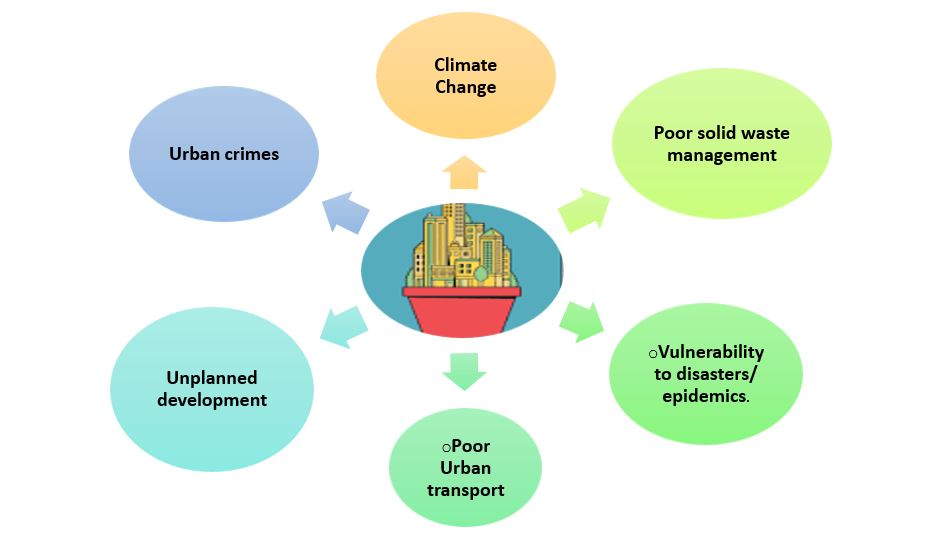
Strategy for Creating Urban Housing Infrastructure:
The government follows a 3-level strategy to address the above-listed challenges:
- Level 1: Poverty alleviation, affordable housing & sanitation. The central government has launched schemes like DAY-NULM, PMAY-U and SBM-U etc., in all Urban Local Bodies (ULBs).
- Level 2: Basic Infrastructure like water supply, sewerage/septage projects and green parks are being implemented in 500 cities, with 1Lakh+ population through AMRUT, Covering 60% of the urban population.
- Level 3: Smart Cities – 100 Smart Cities to address the issue of Ease of Living.

Government Initiatives for Urban Housing: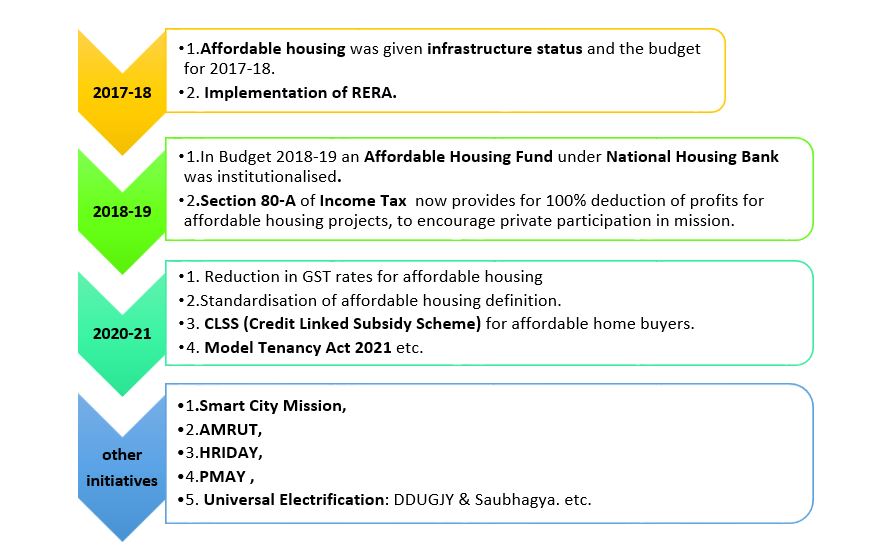
Real Estate (Regulation and Development) Act, 2016:
The Real Estate (Regulation and Development) Act was passed by the Parliament in 2016 and came into effect on May 01, 2017.
It aimed to establish a Real Estate Regulatory Authority (RERA) to regulate and promote the real estate sector and protect consumers’ interests.
Key provisions in Real Estate Act 2016:
- Mandatory Registration:
It makes it obligatory for all commercial and residential projects where the land is over 500 meters2.
- Establishment of Real Estate Appellate Tribunal:
Real Estate Appellate Tribunal (REAT): For speedy dispute redressal, it will now be required to adjudicate cases in 60 days.
- It has been mandated to publish on its websites the information relating to the following:
- Profile and track record of promoters,
- Details of litigations,
-
- Advertisement and prospectus issued about the project,
-
- Details of apartments,
- Plots and garages,
- Registered agents and consultants,
-
- Development plan,
- Financial details of the promoters,
-
- Status of approvals and projects etc.
- Approval procedures for housing and construction projects have been simplified and streamlined in consultation with other line ministries, viz., Environment, Forests and Climate Change, Civil Aviation, Culture, Defence, and Consumer Affairs.
- PMAY guidelines also mandate specific steps in this direction, such as setting up of single online window for construction permits, the concept of deemed building permission and layout approval in certain circumstances, etc.
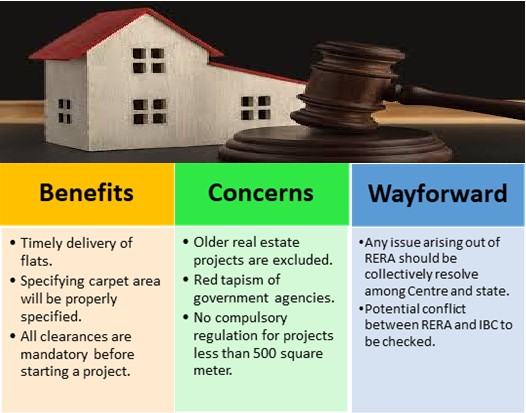
Rental Housing
Rental housing is essential for both horizontal & vertical mobility as it allows people to access suitable accommodation without having to buy it. The Share of households living in rented houses: 5% in rural areas and 31% in urban areas.
Challenges of the Rental Market:

Model Tenancy Act:
The Union Cabinet recently approved the Model Tenancy Act (MTA); according to the government, the MTA will help rent vacant houses. Provisions of the model Tenancy Act (MTA) draft are:
- Compulsory Agreement: An agreement must be reached within a stipulated period and informed to the rental authority.
- Rental Authority: To keep a record of all existing or new agreements.
- Constitution of rent court & Tribunal.
- Quick disposal of cases: The rent authority, rent court, and rent tribunal would fast-track the resolution of disputes within 60 days.
- Limit the Security Deposit: It will limit security deposits for residential premises to a maximum of two months’ rent and a maximum of six months for non-residential purposes. This has to be refunded within a month of vacation.
- Signed Original agreement possession: To be given to the tenant within 15 days of agreement.
- Subletting restricted: Only after written permission from the owner can this be done.
- Intimation of renewal: By the owner two months before the agreement renewal.
- Renewal Provisions: The agreement shall be deemed renewed if no new agreement is registered.
- Regulatory Provisions: Regulation for Notice for the owner’s entry, maintenance and repair of property, role and responsibility of the manager, essential supplies like electricity.
- A digital platform will be established in the vernacular language or the language of the State/UTs for submitting tenancy agreements and other documents. Rent Authority will keep a tab on these agreements.
Significance of the Model Tenancy Act (MTA) draft
- Impact on rental housing:
- Addressing the supply of housing: It will enable the creation of adequate stock of rental housing for all income groups, thereby addressing the issue of homelessness.
- Formalisation: It will enable the institutionalisation of rental housing by serially shifting it towards the formal Market.
- Reduce vacancy rates: It will facilitate unlocking vacant houses for rental housing purposes.
- Cheaper rents would make renting a viable option for tenants and owners.
- Ease of doing business:
- Private investment in housing: It will give a fillip to private players in rental housing as a business model for addressing the housing shortage issue.
- Transparency in agreements: Bringing transparency and accountability in the existing system of renting premises and balancing the interests of both parties judiciously.
- Creating a sustainable and inclusive rental housing market in the country.
India’s housing requirements are complex, but till now, policies have been primarily focused on building more homes and home ownership. However, the need of the hour is a holistic approach considering rentals and vacancy rates. In addition, the government needs to address issues such as rent control and unclear property rights rather than focusing on building more homes under the scheme to provide ‘Housing for all’ by 2022.
As per Economic Survey (2017-18), the following Improvements are required: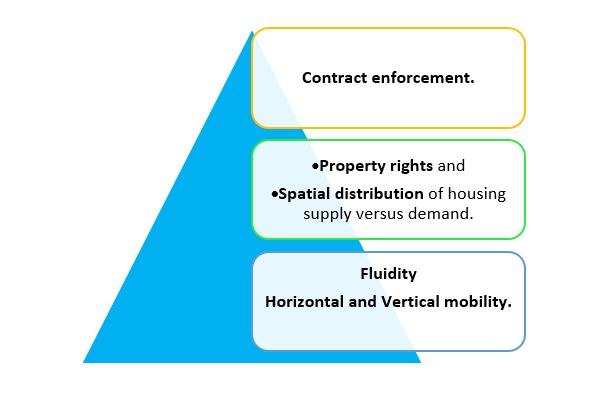
Smart cities
- These will act as incubators of the new Urban India. These are the sites where the ‘urban renaissance’ of India will be collectively envisioned and executed.
- It will have public spaces, providing a spacious, safe, secure environment to live, work, play, and recreate.
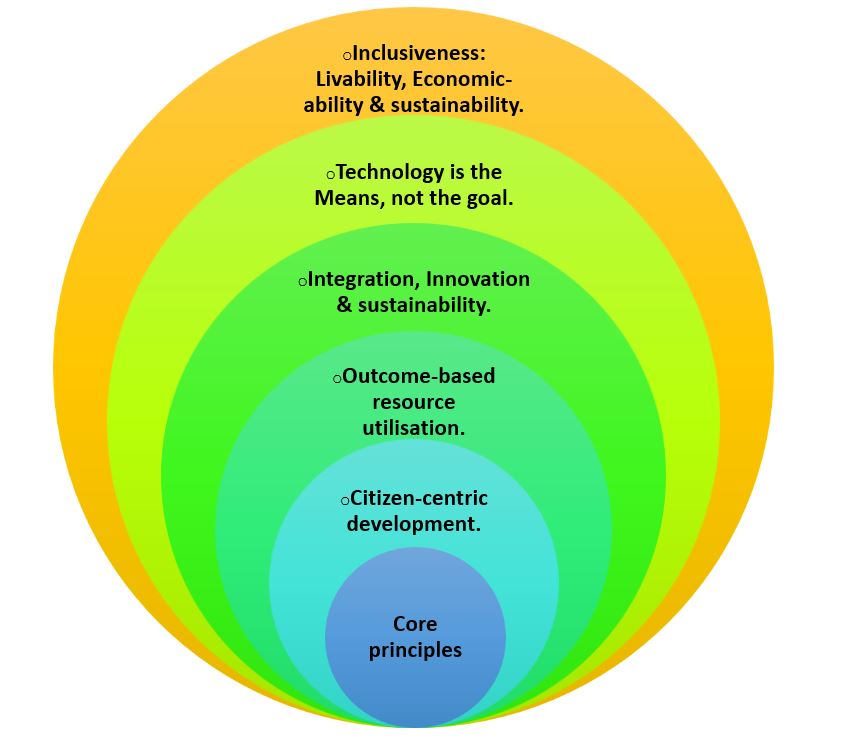
Smart Cities Mission (CSM):
- It was launched in June 2015 as part of the Urban Rejuvenation Mission to develop 100 smart cities by 2019-20, providing 48,000Cr in financial support over 5 years.
- Objective: to promote cities that provide core infrastructure and give its citizens a clean and sustainable environment, decent quality of life and application of ‘Smart’ Solutions.
- The core infrastructure elements:
- Adequate water supply & Assured electricity supply.
- Sanitation, including solid waste management.
- Efficient urban mobility and public transport.
- Affordable housing.
- Robust IT connectivity and digitalisation
- Good governance, particularly e-Governance and citizen participation.
- Sustainable environment.
- Safety and security of citizens, particularly women, children and the elderly.
- Health and education.
100 Smart cities selected till now
(Note: These are not important for either UPSC Prelims or Mains; Although a student must know the smart cities in their respective states)
| Round | Cities |
| Round 1: selected in January 2016 | Bhubaneswar, Pune, Jaipur, Surat, Kochi, Ahmedabad, Jabalpur, Visakhapatnam, Solapur, Davanagere, Indore, NDMC, Coimbatore, Kakinada, Belagavi, Udaipur, Guwahati, Chennai, Ludhiana and Bhopal. |
| Round 2: 13 fast track cities in 2016 | Lucknow, Warangal, Dharmashala, Chandigarh, Raipur, New Town Kolkata, Bhagalpur, Panaji, Port Blair, Imphal, Ranchi, Agartala and Faridabad. |
| Round 3: 27 smart cities, including 8 cities important for pilgrims & tourism | Amritsar, Kalyan-Dombivili, Nagpur, Mangaluru, Vellore, Thane, Gwalior, Rourkela, Kanpur, Tumakuru, Kota, Namachi, Jalandhar, Shivamogga, Salem, Kohima, Hubbali- Dharwad, Aurangabad, Vadodara.
Trourism cities: Ujjain, Tirupati, Nashik, Madurai, Thanjavur, Ajmer, Agra, Varanasi. |
| Round 4: | 30 cities |
| Round 5: | 9 cities |
Important features of Smart Cities Mission:
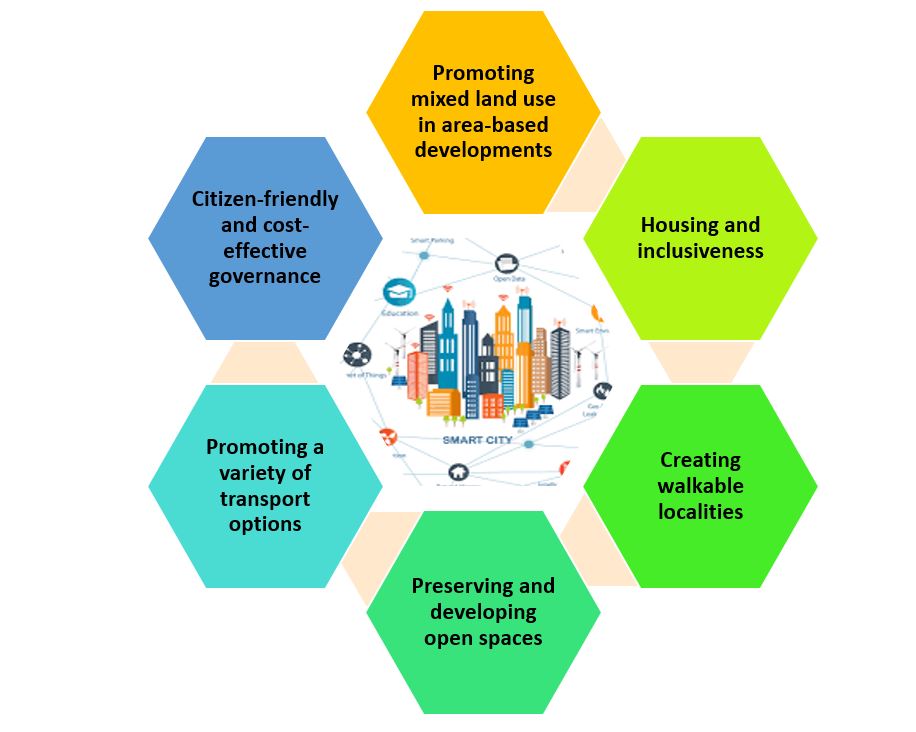
- Promoting mixed land use in area-based developments: The unplanned areas containing a range of land uses close to one another must now be planned to make more efficient use of land.
- Housing and inclusiveness: Dilate housing amenities for all.
- Creating walkable localities: To reduce congestion, air pollution, and resource depletion, promote interactions, boost the local economy and ensure security.
- Road network created/refurbished for vehicles, public transport, pedestrians & cyclists.
- Necessary administrative services are offered within cycling/walking distance.
- Preserving and developing open spaces:
-
- Parks, playgrounds and recreational places should be developed to boost the lifestyle of residents.
- Minimise the urban heat effects in Areas and generally promote eco-balance.
-
- A variety of transport options should be promoted: Transit Oriented Development, public transport and last-mile para-transport connectivity;
- Citizen-friendly and cost-effective governance: Increasing reliance on online services to bring about transparency and accountability, especially using mobiles to cut the cost of services and provide services without going to municipal offices.
- Feedback through e-groups.
- Online monitoring of activities.
- Providing Identity to the city: based on its main economic activities like culture, local cuisine, education, health, textile, goods, arts and crafts, sports furniture, dairy and so on.
- Applying Smart Solutions to Infrastructure and service issues:
Example: making Areas less vulnerable to disasters and providing cheaper sustainable services.
Funding Mechanism of the Smart Cities Mission:
- Implementation: SPVs (a Limited company) was created at the city level with 50:50 share-holding between State and Urban local bodies (ULBs) for smooth implementation.
- The shares can further be disinvested in the Smart City development projects.
- Governance:
- A full-time CEO heads each SPV.
- It has nominees of central, State government and ULBs on its board.
- Execution: The execution of projects may be done through joint ventures, subsidiaries, public-private partnerships (PPP), turnkey contracts, etc., suitably dovetailed with revenue streams.
- Smart City selection Parameters: feasibility, result orientation, citizen participation, smartness of proposals etc.
Integrated development under Smart Cities Mission:
- Smart Railway:
-
- A 5-year MoU has been signed between the MoUD and Railways to redevelop railway stations and surrounding areas under the Smart City plan.
- 100 railway stations and an adjacent area of 300-800 acres would be redeveloped in the Smart Cities and AMRUT Cities plans by NBCC in coordination with other countries.
- It will be extended to over 500 cities in time.
- INDIA URBAN DATA EXCHANGE (IUDX):
-
- It is a research project under the smart cities mission implemented by M/o H&UPA in collaboration with IISc, Bengaluru.
- It is a platform intended to facilitate an easy & efficient data exchange among various Smart Cities stakeholders. It will spend over Rs 16,000 crore — 8% of the total Rs 2.04 lakh crore investment — on IT for digitising municipal operations, such as waste flow, water supply, traffic patterns & surveillance systems.
- Smart City Centre:
-
- IUDX will feed all data into an Integrated Command and Control Center (ICCC).
- It is a centre where the entire city’s information is collected, viewed & analysed through a City operations centre application.
- Through sensors, this system would control street lights, parking lights, parking, traffic (including violations and congestion), waste management, water supply, etc.
- G20 Global Smart Cities Alliance on Technology Governance 2020:
-
- It aims to promote the responsible and ethical use of smart city technologies by establishing global norms and policy standards for the use of connected devices in public spaces.
- India is one of its 15 founding partners.
- Currently, there is no global framework for how sensor data is collected in public spaces.
- WEF shall act as its secretariat.
- Smart Cities Award:
-
- It is launched by M/o H & UPA.
- Nine awards in three categories:
-
-
- Innovative Idea Award: Recognise exceptional Innovation across 7 Urban themes- Governance, Built environment, Social Aspects, Culture and Economy, Urban Environment, Transportation and Mobility, Water and Sanitation- contributing to the successful transformation of cities.
- Project Award: Given to individual Completed projects.
- City Award: project Implementation considered for evaluation.
-
Atal Mission for Rejuvenation and Urban Transformation (AMRUT), 2015:
- Objective: to improve basic urban infrastructure in 500 cities/towns, known as Mission cities/ towns.
- It makes states equal partners in the planning & implementation of projects, thus actualising the spirit of cooperative federalism.
- Concerned Ministry: Ministry of Housing and Urban Affairs.
- Aim: to cover all cities and towns with:
- Population > 1 lakh with notified municipalities, including Cantonment Boards (Civilian areas).
- Certain other cities like capital towns, some cities on the stem of main rivers and tourist & hill destinations.
- To Ensure:
- Water & sewerage: Every household has access to a tap with an assured water supply and a sewerage connection.
- Open spaces: Increase the amenity value of cities by developing greenery and well-maintained open spaces (e.g. parks).
- Public Transport: Reduce pollution by switching to public transport or constructing facilities for non-motorised transport such as walking and cycling tracks.
- Steps involved:

- Central assistance:
- Up to 50% for town/city population of up to 10 lakhs.
- 1-3rd of the project cost for those with a population above 10 lakhs.
- 10% of the budget allocation to states & UTs as an incentive based on the achievement of reforms during the previous year.
- States will transfer funds to ULBs within 7 days of transfer by the central government.
- Seeking to ensure timely implementation of basic urban infrastructure projects and achieve mission targets by 2019-20, MoUD has begun approving investments in water supply, sewerage networks etc., for the next three financial years under AMRUT.
National Heritage City Development and Augmentation Yojana (HRIDAY):
Aim:
-
- To preserve and revitalise the soul of the heritage city to showcase the city’s unique character by manifesting an aesthetically appealing, accessible, informative and secure environment.
- Focusing on advancing the entire ecosystem, including its citizens, tourists and local businesses.
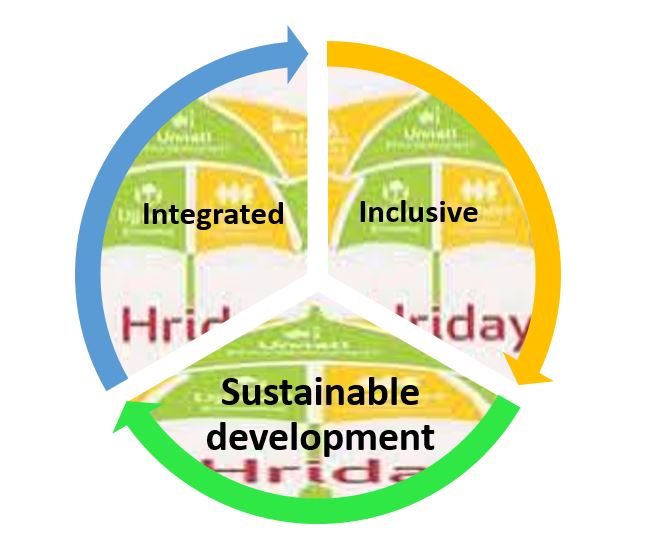
- Concerned Ministry: Ministry of M/o Housing & Urban Development.
- The scheme is being executed in 12 identified cities: Ajmer, Amaravati, Amritsar, Badami, Dwarka, Gaya, Kanchipuram, Mathura, Puri, Varanasi, Velankanni and Warangal.
- Central government scheme: states and local urban bodies are requested to supplement their resources to develop heritage cities rapidly.
- The project will work as a partnership of the Government, Academic Institutions and the local community combining affordable technologies.
- With 40(1 mixed site) UNESCO-recognised natural and cultural heritage sites, ranking sixth in the world, the country’s tourism potential is still to be fully harnessed, and this scheme will help in this regard.




